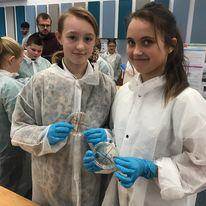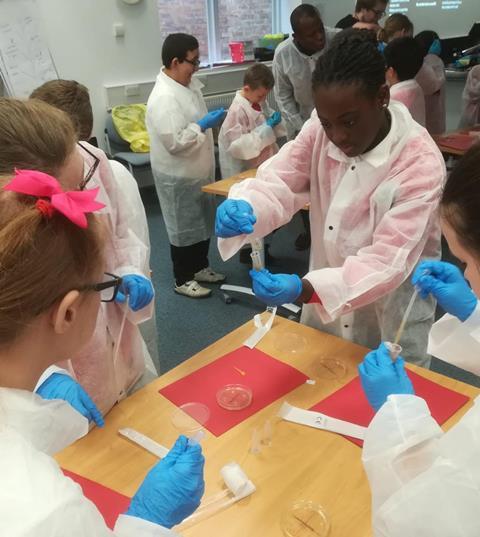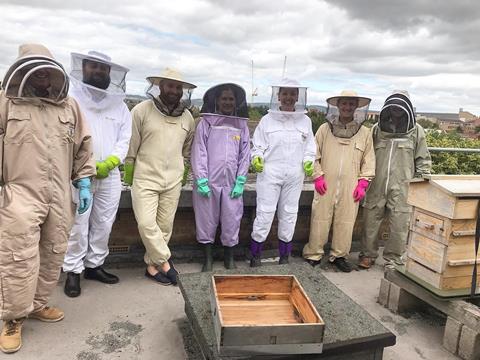It’s the burning ambition you never knew you had - to be immortalised as a scientist honey bee in a children’s book!
Professor Les Baillie of Cardiff University has had a few unique experiences as a microbiologist - being polygraphed by the FBI is one he mentions with particular glee - but becoming one of the stars of Betsy and Bertie Save The Bees is one that earned particular kudos from his granddaughter.
The book, published by 2B Enterprising, is supported by an Educational Resource Grant from Applied Microbiology International and is part of the Bumbles of Honeywood series targeted at primary school aged children in Wales.
Wide interests
Professor Baillie, from the School of Pharmacy and Pharmaceutical Sciences, is known for his research interests in anthrax, but also has a passion for uncovering native pharmaceuticals that could help in the fight against antimicrobial resistance.

But his involvement in STEM education began in 2014 when he joined a drive by Welsh universities to collaborate with teachers in developing innovative educational resources prompted by a worrying trend in which students in Wales were not performing as well in science-based subjects as their counterparts elsewhere in the UK.
Drug discovery
“Our contribution to this effort owes its genesis to the work of a talented young PhD student called Jenny Hawkins who employed honey bees as a drug discovery tool,” he says.
“Using this approach we identified a number of native plants which contained antimicrobial compounds with activity against antibiotic-resistant human pathogens such as MRSA. With the support of a small public engagement grant from the Wellcome Trust, we created a series of engagement activities for local primary schools which linked antimicrobial resistance and drug discovery with biodiversity and climate change in a manner which pollinated young minds.

Indeed, the human fascination with bees has provided us with a vehicle to capture and hold the attention of students, both young and old. Building on this sense of wonder and to create a buzz amongst the next generation of Welsh scientists we have developed, in partnership with school teachers and children, a range of educational resources which can be accessed via our schools resources website.”
Vital tools
These tools cover microorganisms, good and bad bacteria, where they can be found on the body and in the environment and how they spread, with a particular focus on the importance of hand washing. The resources also cover antibiotic resistance and the work being done at Cardiff University to find new antibiotics in partnership with bees.
“While our focus to date has been the development of STEM-based resources, we realise the importance of the arts and humanities. For this reason, we were keen to work with creative individuals to develop educational resources which resonate with students in an exciting and original manner,” Professor Baillie says.

“Fortuitously, prior to lockdown I was introduced to Sue Poole, who is an accomplished children’s author and award-winning entrepreneur based in Swansea. As a consequence of participating in a Welsh Government ministerial task group exploring ways of embedding enterprise education in the new school curriculum, she was inspired to create a book series called the Bumbles of Honeywood, targeted at primary school children.
“Bees have many of the skills that we want our children to develop - they work well as a team, they are hard-working, can solve problems and are able to innovate and, as we recently discovered, they can help us discover new antimicrobial compounds.”
Pandemic story
Over a number of conversations, they developed a story in which the bees prepared themselves for the arrival of a pandemic - in this case, a spore-forming bacterium called Paenibacillus larvae which is the causative agent of a fatal disease in honeybees called American foulbrood.
“Our two heroes, Betsy and Bertie Bumble, worked together in the Honeywood University Research Laboratory to develop testing kits and medicine such as vaccines to protect the hive from the coming pestilence,” Professor Baillie says.
“They are assisted in this task by Professor Baillie from Cardiff University. My appearance as a cartoon character in the story has scored me more points with my granddaughter than anything else I have done in the rest of my 30+ year career in microbiology!
Real world reflection
“Through the story, we explored a range of issues such as hand washing, social distancing, rapid diagnostics and vaccines, which were particularly relevant in the context of the pandemic which was occurring in the real world.”
The team trialled the story and associated STEM activities with primary school teachers and the children themselves, using the impact to refine the final story. The book is now published and available as a resource for local primary schools.
Professor Baillie’s career in microbiology has taken quite a few twists and turns - after starting off as a microbiologist in 1982, he spent around 12 years working for the NHS in a variety of clinical and research labs, including St Thomas’s and King’s College London, carrying out research related to clinical microbiology.
Porton Down
He studied part time for an MPhil at UWE, working on Pseudomonas and antiseptic resistance, and was then offered a job in 1990 by the Ministry of Defence at Porton Down.
“I ended up as the anthrax research lead, developed a next generation anthrax vaccine and was part of the team which sequenced the Bacillus anthracis genome, resulting in a Nature paper, which was nice, and I was involved in all sorts of interesting projects including cloning myself. I also found time to complete a part time PhD with the university of Sheffield!
“But after about 12 years of being a civil servant, I was headhunted by the University of Maryland, in Baltimore, Maryland, who offered me a lab and a big wodge of money,” he says.
Biodefense in the US
“So I moved to the United States and ran a research lab in downtown Baltimore, but while I was there I was seduced by even more money from the US Navy who gave me a building. I ended up running their biodefense medical countermeasure group in Washington, during which time I was involved in the FBI investigation of the anthrax mail attacks - which was when I was polygraphed.”
It was only when he returned to Cardiff, having been offered a chair at the university, that his fascination with the idea of honey as an antimicrobial evolved.

“I still muck around with nasty bugs - I am a subject matter expert on anthrax and have projects in Türkiye and Ukraine - but in 2012 I became interested in the idea of exploring honey as a source of antibiotics,”
Power of honey
“Manuka honey from New Zealand is very expensive due to its antimicrobial properties and the reason for this is because the bees that make this honey feed on the Manuka bush, which produces a nectar which contains a natural antibiotic called methylglyoxal.
“So the premise of my research was if New Zealand bees can make antimicrobial honey using food from certain plants, are there similar plants in the UK?
“If you think about it, a sample of honey contains nectar from the flowering plants that surround hives and are visited by the bees. So, if there is an antibiotic in the nectar produced by a particular plant it will be incorporate into honey which you can then screen for activity. But how do you then find the plant which was the original source of the antibacterial nectar ? Well, of course the reason why plants make nectar is to attract bees to pick up and spread there pollen which contains DNA and some of which finds its way into the raw honey.
“In the UK, we have a DNA database of all our native flowering plants, so what that means is that we can sequence the pollen in a honey sample and identify the plants that the bees visited to make the honey.”
Beehive and beyond
Working with PhD student Jenny Hawkins, they identified a range of plants that had antibiotic properties and started growing them around the School of Pharmacy in Cardiff.
“We then started getting interested in putting beehives on university buildings - we put one on the roof of my school, trained staff to be beekeepers and helped install hives on university buildings across the campus,” Professor Baillie says.

“As a result of this work we became a bee-friendly university which was nice, but then we thought ‘well this is a cool way to talk to children’. Everyone has an opinion about bees!
“It became a vehicle to have a conversation around discovery, around microbiology, but also around biodiversity and climate change. And off the back of that, it has grown.

“Currently, we run a whole series of school engagement activities across South Wales. One such project in partnership with Cardiff Council is a project called the Children’s University, which is an initiative to encourage children from deprived areas to get more involved in STEM-based activities.
Time shift
“In support of a community project in Abercynon, we are creating a nature trail through time in which we plan to grow medicinal plants from different eras. We’re creating a Neolithic space and work is just about to start on the construction of a roundhouse. Once completed we will grow plants such as Emmer wheat which was one of the first domestical cereal crops and medical plants used by our ancestors to treat diseases.
“We have created a Roman physic garden where we will be growing medicinal plants used by the Romans, a number of which contain antimicrobial compounds. We have also created a medieval space based on medical plants, and have just installed a beehive so the community can start to make their own honey.”

The university is also supporting a schools project on climate change called Climate Classroom, which includes a focus on the role of the photosynthetic cyanobacteria Arthrospira platensis (Spirulina) in restoring the atmosphere.
Building the atmosphere
“We talk to primary school children about air quality, climate change, about the role of carbon dioxide. We also talk about the role of bacteria in actually creating the atmosphere, he says.
“Based on technology from the space station, we give the kids a sachet of spirulina, a photosynthetic bacterium which is also a health food supplement, and get them to capture CO2 in their classrooms.
“We show that as it sucks up CO2, the weight of the container goes up so they could measure the conversion of CO2, into biomass. What’s cool is that in addition to trapping carbon they can also use the spirulina to make cupcakes.”
Back with the bumbles
Professor Baillie says he would be interested in helping with a future Bumbles of Honeywood book on the subject of climate change if the opportunity arises.
“In the future I would be keen to assist in the creation of more stories for Bertie and Betsy in which they tackle issues such as climate change and the role that microorganisms play in creating the air we breathe,” he says.
“This first use of a creative medium to deliver key science messages has stimulated the team to explore other ways of sharing our research with the wider community.”
Les Baillie is Professor of Microbiology at the School of Pharmacy and Pharmaceutical Sciences in Cardiff University.
To find out more about AMI’s grants and awards, click HERE.
Topics
- 2B Enterprising
- American Foulbrood
- anthrax
- Applied Microbiology International
- Arthrospira platensis
- Bacteria
- Be inspired
- Bumbles of Honeywood
- Climate Action
- Climate Classroom
- Community
- FBI
- honey
- Jenny Hawkins
- King’s College London
- Les Baillie
- manuka honey
- methylglyoxal
- One Health
- Paenibacillus Larvae
- Pharmaceutical Microbiology
- Porton Down
- Pseudomonas
- spirulina
- Sue Poole
- UK & Rest of Europe
- University of Maryland







No comments yet